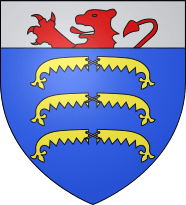List of lords and princes of Joinville

The first known lord of Joinville (French Sire or Seigneur de Joinville) in the county of Champagne appears in the middle of the eleventh century. The lordship was raised into a principality by Henry II in 1551. It lasted until the abolition of feudalism in 1789. The title Prince of Joinville (French Prince de Joinville) continues in use as a courtesy title to this day.
History
Joinville (from medieval Latin Jonivilla or Junivilla) lies on the river Marne in eastern Champagne. In the early eleventh century, when a castle was built or possibly just enlarged at the site, it lay close to the border between the Kingdom of France and the Holy Roman Empire. The family of the lords of the castle rose to prominence late in the eleventh century when they acquired a second castle of Vaucouleurs. From then on the lord of Joinville, as one of the few "multicastle" lords in Champagne, regularly attended the court of his superior, the count of Troyes. Lord Geoffrey III followed Count Henry I on the Second Crusade (1147–49) and afterwards was appointed seneschal of Champagne (1152), an office that became hereditary in his family.[1]
The Joinville family patronised the Cistercian monasteries of Clairvaux and La Crête, but their relationship with the nearby Benedictine house of Montier-en-Der was one of rivalry. The family also had influence in local cathedral chapters. Guy was elected bishop of Châlons (1164–90) with the help of Count Henry I, and William became bishop of Langres (1209–19).[1]
In the 13th century, the lordship of Joinville was gradually diminished as sub-lordships were carved off for younger sons. In 1204, Lord Geoffrey V and his younger brother Robert died while on the Fourth Crusade. Since William had entered the church, the lordship passed to the fourth brother, Simon, while the fifth, Guy was given Sailly and established a cadet lineage. Simon's sons again divided the lordship: Joinville and the seneschalcy went to John, while Vaucouleurs passed to Geoffrey and Simon received Marnay.[1]
Lords
House of Vaux
- ????–???? Stephen
- ????–1080 Geoffrey I
- 1080–1096 Geoffrey II
- 1096–1128 Roger
- 1128–1184 Geoffrey III, also seneschal of Champagne
- 1184–1197 Geoffrey IV
- 1197–1204 Geoffrey V, also seneschal of Champagne
- 1204–1233 Simon, also seneschal of Champagne
- 1233–1317 John, also seneschal of Champagne
- 1317–1343 Anselm, also seneschal of Champagne
- 1343–1386 Henry, also seneschal of Champagne and count of Vaudémont
House of Vaudémont
- 1386–1415 Frederick I, also count of Vaudémont
- 1415–1447 Anthony, also count of Vaudémont
- 1447–1470 Frederick II, also count of Vaudémont
- 1470–1476 Nicholas
- 1476–1508 René, also duke of Lorraine
- 1508–1550 Claude, also duke of Guise
- 1550–1551 Francis, also duke of Guise
Princes
House of Guise
- 1551–1563 Francis, also duke of Guise
- 1563–1588 Henry I, also duke of Guise
- 1588–1640 Charles, also duke of Guise
- 1640–1641 Henry II, also duke of Guise
- 1641–1654 Henriette Catherine, also duchess of Joyeuse
- 1654 Louis (I), also duke of Joyeuse
- 1654–1671 Louis Joseph, also duke of Guise
- 1671–1675 François Joseph, also duke of Guise
- 1675–1688 Marie, also duchess of Guise
House of Orléans
From 1789 on, the principality is defunct but the title continues to be used.
- 1688–1693 Anne-Marie-Louise, also duchess of Montpensier
- 1693–1701 Philippe I, also duke of Orléans
- 1701–1723 Philippe II, also duke of Orléans
- 1723–1752 Louis (II), also duke of Orléans
- 1752–1785 Louis-Philippe I, also duke of Orléans
- 1785–1793 Louis-Philippe II, also duke of Orléans
- 1793–1850 Louis Philippe III, also king of France
- 1850–1900 François
- 1900–1919 Pierre, also duke of Penthièvre
- 1919–1940 Jean, also duke of Guise
- 1940–1999 Henri (III), also count of Paris
- 1999– Henri (IV), also count of Paris
Notes
- 1 2 3 Evergates 2007, pp. 173–74.
References
- Delaborde, Henri-François (1894). Jean de Joinville et les seigneurs de Joinville, suivi d'un catalogue de leurs actes. Paris: Picard et fils.
- Evergates, Theodore (2007). The Aristocracy in the County of Champagne, 1100–1300. Philadelphia: University of Pennsylvania Press.